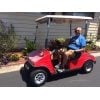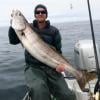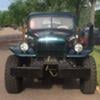
10 ply tire pressure
#11

Posted 22 February 2017 - 02:05 AM
I will say I agree with you on your perspective on tires rated to carry loads over passenger tires. My feeling is the tire manufacturer is giving the max pressure with a max weight rating. So looking at a set of tires rating vs what the actual weight is, when it's lower than max weight, one must find a way to get closeer to tire pressure for their specific loaded weight. Just pumping up to max tire pressure could be just as poor an option as staying with car maker tire pressure in the door jam for different tires. Just my two cents.
Russ
#12

Posted 22 February 2017 - 04:21 AM
I upgraded the OEM "P" tires to "E", same size, before I got the camper. Since they are the same size, I use the door-post pressure when the camper is off the truck, which gives about the same ride as with the "P" tires.
Before I put the camper on for the first time, I measured the length (front-to-back) of the flat section of the tread in contact with the pavement. With the camper in place, I pumped up the tires until that area was the same length, resulting in 60 PSI rear and 40 PSI front. The truck rides and handles well with these pressures. I didn't want to use too much pressure and reduce my traction. The maximum pressure, as marked on the tire, is 80 PSI.
I took these measurements using a couple of thin plastic strips, about a foot long. I laid the strips flat on the pavement, one in front of the tire and one behind, perpendicular to the axis of the truck. Then I slide the strips in until they were touching the tread and measured the distance between them.
I don't remember where I got this idea, but it seems logical and has resulted in a good ride and handling. I haven't driven far enough yet to see how the tires are wearing.
- Bernard
I like this idea. I've used a similar technique using a feeler gauge. I "over inflate" the tire to the point where I can push the gauge in from the side at the middle of the contact patch, say 1/2". Then deflate and retest until I can't push it in any more. I ASSUME that this means the whole tire is now contacting the road.
The chalk test is good too. Even better is a tire temp gauge, which is what I used when I spent more time on the racetrack!
2012 ATC Puma Shell build - https://www.wanderth...012-puma-build/
Power considerations thread - https://www.wanderth...e-power-scotty/
Building out an electrical system - So, you want to setup a good electrical system in your camper? - Electrical, Charging, Solar, Batteries and Generators - Wander the West
#13

Posted 22 February 2017 - 06:25 PM
Here is a thought...go to the tire mfger website and get their number for Customer Service.....ask a technician what tire pressure these tires should be running on. I'm interested in what they say with regard to any tire warrantee problems with running underinflated and what exactly is the range of PSI the tire will perform as it should with....and still not void the warrantee.
1988 Ford F-250 HD Lariat 4x4 8 Ft. bed
1976 Alaskan 8 Ft. CO camper
#14

Posted 22 February 2017 - 06:29 PM
Yep weigh the truck loaded front and rear. Then send the axle weights to the manufacturer. Tell them what truck and how you use it. They will give you a pressure setting that is close to what you need. Just went through this.
http://www.wanderthe...d-air-pressure/
#15

Posted 23 February 2017 - 12:05 AM
We run our Hankook 10 plys at 35 pounds on the highway with the camper shell bolted down full time
and have a great ride. We drop them to 30 pounds offroad.
#16

Posted 23 February 2017 - 05:57 AM
I run my Dodge Ram 2500 4wd diesel with Michelin LTX at 70 lbs front and rear all the time. I'll increase it to 80 psi when the camper is on.
2018 Dodge Ram 2500 Quad Cab, 4WD, CTD paired with a 2013 FWC Hawk
#17

Posted 23 February 2017 - 02:02 PM
We run the 315/70R17's under our 3/4t CTD at 50 psi. Wear is even across the width of the tires. I feel that the chalk test is the best way to get a starting pressure, then fine tune from there if/as needed. When we do drop the pressure for off-pavement I only go to 40 psi, and that is rare.
Where does that road go?
#18

Posted 23 February 2017 - 06:36 PM
My F150 VIN tag indicated P235/75R 15XL tires and 35/41 PSI.(GVWR 6450 lbs.)
My F250 VIN tag indicates LT235/85R 16E tires and 51/80 PSI. (GVWR 8800 lbs.)
So...with the same Alaskan on each truck....would I lower the air pressure on the 16E tires to 35/41 if I put them on the F150?
Uh....no....just like I would not raise the PSI on the 15XL tires to 50/80 PSI if I put them on my F250.
Tire pressures recommended by Ford and the tire mfgers are already based on the LOAD you are carrying, meaning your GVWR (which is much higher on the F250 than the F150) so go with what the tire mfger suggests if you can provide them with the front/rear GVWR of your FULLY LOADED truck & camper with food/water/fuel/equipment/passengers being weighed as suggested above.
Just sayin'.......
1988 Ford F-250 HD Lariat 4x4 8 Ft. bed
1976 Alaskan 8 Ft. CO camper
#19

Posted 23 February 2017 - 08:06 PM
The chalk test is good too. Even better is a tire temp gauge, which is what I used when I spent more time on the racetrack!
When I was racing we had a Goodyear, Firestone or Hoosier engineer around to tell us what the tire temperatures should be for a given track and tire combination.
The best information I have found on correct tire inflation pressure is from Toyo Tires:
https://toyotires-15...es_20151020.pdf
Their are a number of variables tire manufacturers juggle to determine correct tire inflation: load bearing, traction, heat build-up, squirm, deflection under side load, spring rate, rolling resistance, tread wear . . . The chalk test doesn't cover most of them.
jim
#20

Posted 25 February 2017 - 04:33 PM
All the chalk test was ever intended to do was to find the pressure that resulted in full tread width contact for the theoretical best/longest wear. It is a quite old and simple test. Asking it to do more than that is unfair.
I had a boss once who drove 93 miles one-way door to door 4 days a week for over a decade in an Audi 4E. Being a CPA by training he kept a detailed log of everything ever done to his cars. When he retired it to his wife's use the rear Michelin XZX's had over 100,000 miles on them. He did not rotate them and he ran them at the tire's max cold pressure rating, checked cold weekly. At that pressure and with so little rear weight on them I doubt that those tires ever had full tread width contact, but it didn't matter.
Maybe I'm wearing our tires out prematurely, but I have more important things to do than to obsess over tire pressure. The chalk test, wear indication, and ride quality are my three stds of judgement. After that I'll be doing something else.
Where does that road go?
0 user(s) are reading this topic
0 members, 0 guests, 0 anonymous users




















